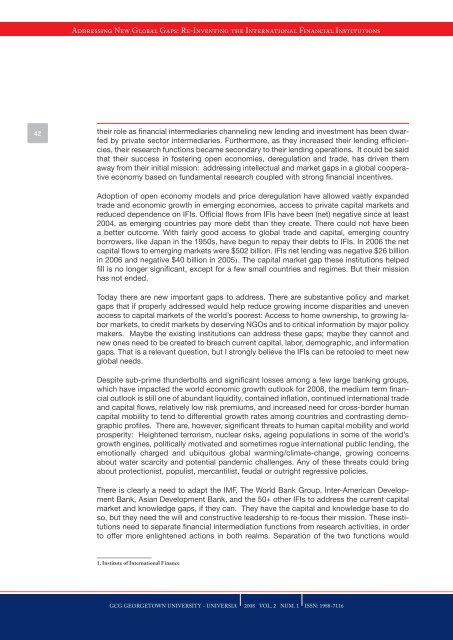2008 Vol. 2 Num. 1 - GCG: Revista de Globalización, Competitividad ...
2008 Vol. 2 Num. 1 - GCG: Revista de Globalización, Competitividad ...
2008 Vol. 2 Num. 1 - GCG: Revista de Globalización, Competitividad ...
Create successful ePaper yourself
Turn your PDF publications into a flip-book with our unique Google optimized e-Paper software.
Addressing New Global Gaps: Re-Inventing the International Financial Institutions42their role as financial intermediaries channeling new lending and investment has been dwarfedby private sector intermediaries. Furthermore, as they increased their lending efficiencies,their research functions became secondary to their lending operations. It could be saidthat their success in fostering open economies, <strong>de</strong>regulation and tra<strong>de</strong>, has driven themaway from their initial mission: addressing intellectual and market gaps in a global cooperativeeconomy based on fundamental research coupled with strong financial incentives.Adoption of open economy mo<strong>de</strong>ls and price <strong>de</strong>regulation have allowed vastly expan<strong>de</strong>dtra<strong>de</strong> and economic growth in emerging economies, access to private capital markets andreduced <strong>de</strong>pen<strong>de</strong>nce on IFIs. Official flows from IFIs have been (net) negative since at least2004, as emerging countries pay more <strong>de</strong>bt than they create. There could not have beena better outcome. With fairly good access to global tra<strong>de</strong> and capital, emerging countryborrowers, like Japan in the 1950s, have begun to repay their <strong>de</strong>bts to IFIs. In 2006 the netcapital flows to emerging markets were $502 billion. IFIs net lending was negative $26 billionin 2006 and negative $40 billion in 20051. The capital market gap these institutions helpedfill is no longer significant, except for a few small countries and regimes. But their missionhas not en<strong>de</strong>d.Today there are new important gaps to address. There are substantive policy and marketgaps that if properly addressed would help reduce growing income disparities and unevenaccess to capital markets of the world’s poorest: Access to home ownership, to growing labormarkets, to credit markets by <strong>de</strong>serving NGOs and to critical information by major policymakers. Maybe the existing institutions can address these gaps; maybe they cannot andnew ones need to be created to breach current capital, labor, <strong>de</strong>mographic, and informationgaps. That is a relevant question, but I strongly believe the IFIs can be retooled to meet newglobal needs.Despite sub-prime thun<strong>de</strong>rbolts and significant losses among a few large banking groups,which have impacted the world economic growth outlook for <strong>2008</strong>, the medium term financialoutlook is still one of abundant liquidity, contained inflation, continued international tra<strong>de</strong>and capital flows, relatively low risk premiums, and increased need for cross-bor<strong>de</strong>r humancapital mobility to tend to differential growth rates among countries and contrasting <strong>de</strong>mographicprofiles. There are, however, significant threats to human capital mobility and worldprosperity: Heightened terrorism, nuclear risks, ageing populations in some of the world’sgrowth engines, politically motivated and sometimes rogue international public lending, theemotionally charged and ubiquitous global warming/climate-change, growing concernsabout water scarcity and potential pan<strong>de</strong>mic challenges. Any of these threats could bringabout protectionist, populist, mercantilist, feudal or outright regressive policies.There is clearly a need to adapt the IMF, The World Bank Group, Inter-American DevelopmentBank, Asian Development Bank, and the 50+ other IFIs to address the current capitalmarket and knowledge gaps, if they can. They have the capital and knowledge base to doso, but they need the will and constructive lea<strong>de</strong>rship to re-focus their mission. These institutionsneed to separate financial intermediation functions from research activities, in or<strong>de</strong>rto offer more enlightened actions in both realms. Separation of the two functions would1. Institute of International Finance<strong>GCG</strong> GEORGETOWN UNIVERSITY - UNIVERSIA <strong>2008</strong> VOL. 2 NUM. 1 ISSN: 1988-7116















